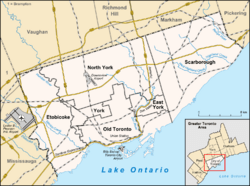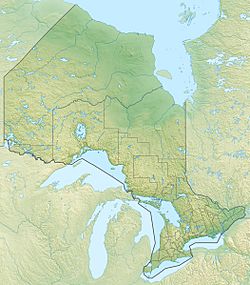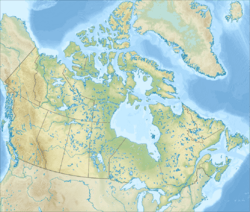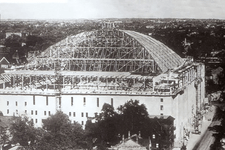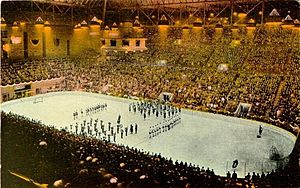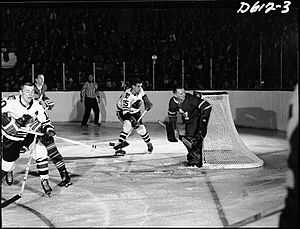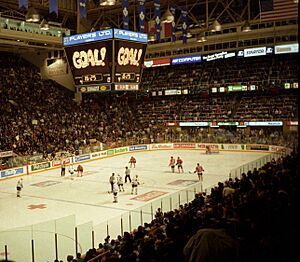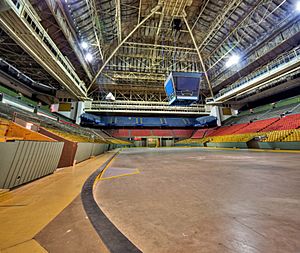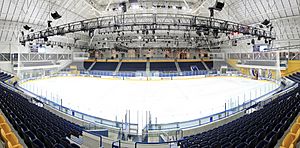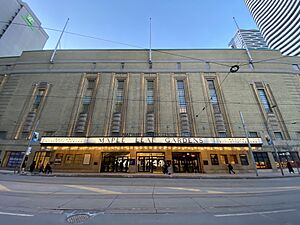Maple Leaf Gardens facts for kids
|
"The Carlton Street Cashbox"
"The Church of Hockey" MLG "The Shrine" |
|
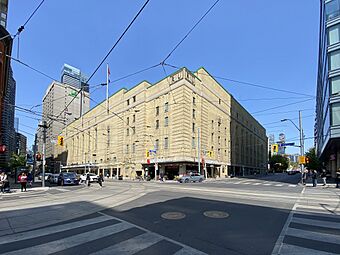 |
|
| Address | 60 Carlton Street |
|---|---|
| Location | Toronto, Ontario |
| Coordinates | 43°39′44″N 79°22′49″W / 43.66222°N 79.38028°W |
| Public transit | |
| Owner | Toronto Metropolitan University Loblaw Companies Ltd. (2004–present) Former owner Maple Leaf Gardens Ltd. (1931–2004) |
| Operator | Toronto Metropolitan University Loblaw Companies Ltd. (2004–Present) Former Operator Maple Leaf Gardens Ltd. (1931–2004) |
| Executive suites | 3 suites, 1 alumni lounge (Mattamy Athletic Centre) |
| Capacity | Ice hockey: 12,473 (1931–1940), 12,586 (1940–1960)1, 13,718 (1960–1966)2, 15,461 (1966–1968)3, 16,316 (1968–1981)4, 16,182 (1981–1991)5, 15,642 (1991–1992), 15,720 (1992–1993), 15,728 (1993–1994), 15,646 (1994–1996)6, 15,726 (1996–2012), 2,539 (2012–present)7 114,550 with standing room 214,650 with standing room 316,161 with standing room 416,485 with standing room 516,382 with standing room 615,746 with standing room 72,796 with additional amenities |
| Construction | |
| Broke ground | May 30, 1931 |
| Opened | November 12, 1931 |
| Construction cost | C$1.5 million ($25.9 million in 2021 dollars ) |
| Architect | Ross and Macdonald |
| General contractor | Thomson Brothers Construction |
| Tenants | |
| Toronto Maple Leafs (NHL) (1931–1999) Toronto Marlboros (OHL) (1931–1989) Toronto Huskies (BAA) (1946–1947) Buffalo Braves (NBA) (1971–1975) Toronto Toros (WHA) (1974–1976) Toronto Raptors (NBA) (1997–1999) Toronto Rock (NLL) (1999–2000) Mattamy Athletic Centre TMU Bold (U Sports) (2012–present) Toronto Sceptres (PWHL) (2023—2024) Retail Loblaws (2004–present) |
|
| Website | |
| Mattamy Athletic Centre | |
| Designated: | 2007 |
| Designated: | 1991 |
Maple Leaf Gardens is a famous and historic building in Toronto, Ontario. For almost 70 years, it was one of the most important arenas in the world for ice hockey. It was built in 1931 and was the home of the Toronto Maple Leafs of the National Hockey League (NHL) until 1999.
Considered one of the "cathedrals" of hockey, the Gardens was where the Maple Leafs won 11 Stanley Cup championships. Many other sports teams played there, including the Toronto Huskies of the Basketball Association of America (which later became the NBA) and the Toronto Raptors.
The arena also hosted some of the biggest names in music. Elvis Presley performed there in 1957, and The Beatles played at the Gardens on all three of their North American tours.
After the Maple Leafs moved to a new arena in 1999, the building was renovated. Today, it has a Loblaws grocery store on the lower floors and a modern athletic centre for Toronto Metropolitan University on the upper levels, called the Mattamy Athletic Centre at the Gardens.
Contents
History
Building a Hockey Palace
In the 1930s, the manager of the Maple Leafs, Conn Smythe, had a big dream. He wanted to build a new, modern arena for his team. The team's old home, the Mutual Street Arena, was too small.
To get the money for the new building, Smythe's company, Maple Leaf Gardens Limited, sold shares to the public. Many construction workers even agreed to be paid partly in shares to help make the dream a reality.
Construction started on June 1, 1931. In an amazing achievement, the building was finished in just over five months! The total cost was $1.5 million, a huge amount of money at the time.
The Golden Years: 1931–1960
The Gardens opened on November 12, 1931. In their very first season in the new building, the Maple Leafs won the Stanley Cup!
The arena quickly became a center for all kinds of events. It hosted professional wrestling, boxing, and even speeches from famous people like Winston Churchill. During World War II, large rallies were held at the Gardens to support Canada's soldiers.
On November 1, 1946, a historic event took place at the Gardens. The first-ever game of the Basketball Association of America (which later became the NBA) was played. The Toronto Huskies hosted the New York Knickerbockers.
Many famous musicians and performers also came to the Gardens. Elvis Presley's concerts on April 2, 1957, were his first ever outside the United States.
A New Era of Ownership: 1961–1990
In 1961, Conn Smythe sold most of his shares in the Gardens. The new owners, including his son Stafford Smythe and Harold Ballard, made the arena even bigger by adding more seats.
During the 1960s, the Gardens became a top spot for concerts. The Beatles played there three times, in 1964, 1965, and 1966. It was the only place they played on all three of their North American tours.
In 1966, a boxing match featuring Muhammad Ali was scheduled at the Gardens. Conn Smythe disagreed with Ali's views on the Vietnam War and resigned from the board of directors in protest.
After Stafford Smythe passed away in 1971, Harold Ballard became the main owner. The Leafs were so popular that every game was sold out for decades. This earned the arena the nickname "The Carlton Street Cashbox." Many famous musicians, like Queen, Rush, and Bob Marley, also performed at the Gardens during this time.
The Final Years as an NHL Arena: 1991–2003
By the 1990s, many sports teams were building bigger, more modern arenas. Maple Leaf Gardens was getting old and didn't have modern features like luxury boxes. A new company, Maple Leaf Sports & Entertainment, took over the team and the building. They decided to build a new home for the Leafs and the city's basketball team, the Toronto Raptors.
The Raptors played a few games at the Gardens when their other arena was not available. The Maple Leafs played their last game at the Gardens on February 13, 1999, losing to the Chicago Blackhawks. It was an emotional night, with many former players returning to say goodbye to the famous building.
The last professional sports team to win a championship at the Gardens was the Toronto Rock of the National Lacrosse League. They won the league title there in 1999 and 2000.
A New Life for the Gardens
Loblaws and Toronto Metropolitan University
After the Leafs left, the building was empty for nearly a decade. People worried about what would happen to the historic arena. In 2009, a new plan was made to save it.
The building was completely renovated inside. The lower floors became a large Loblaws grocery store, and the upper levels were turned into a modern athletic centre for Toronto Metropolitan University (TMU).
The new Loblaws store opened in 2011. It has many features that honor the building's history. A red dot on the floor marks the exact spot where centre ice used to be. There is also a huge sculpture of a maple leaf made from the old blue arena seats.
Mattamy Athletic Centre at the Gardens
The new sports facility is called the Mattamy Athletic Centre at the Gardens. It has a full-sized ice rink on the top floor, right under the famous domed roof. It also has a gym and courts for basketball and volleyball.
It is the home of the university's sports teams, the TMU Bold. The centre has also hosted major events like the 2015 Pan American Games, professional curling tournaments, and the 2017 Invictus Games.
In 2024, the arena was the first home for Toronto's team in the new PWHL. The very first game in the league's history was played there on January 1, 2024.
Recognition
In 2007, Maple Leaf Gardens was named a National Historic Site of Canada. This was because it was one of the most famous "shrines" in hockey history. It also hosted many important sporting and cultural events for the country.
The building is also protected under the Ontario Heritage Act, which means its historic character must be preserved.
See also
 In Spanish: Maple Leaf Gardens para niños
In Spanish: Maple Leaf Gardens para niños


